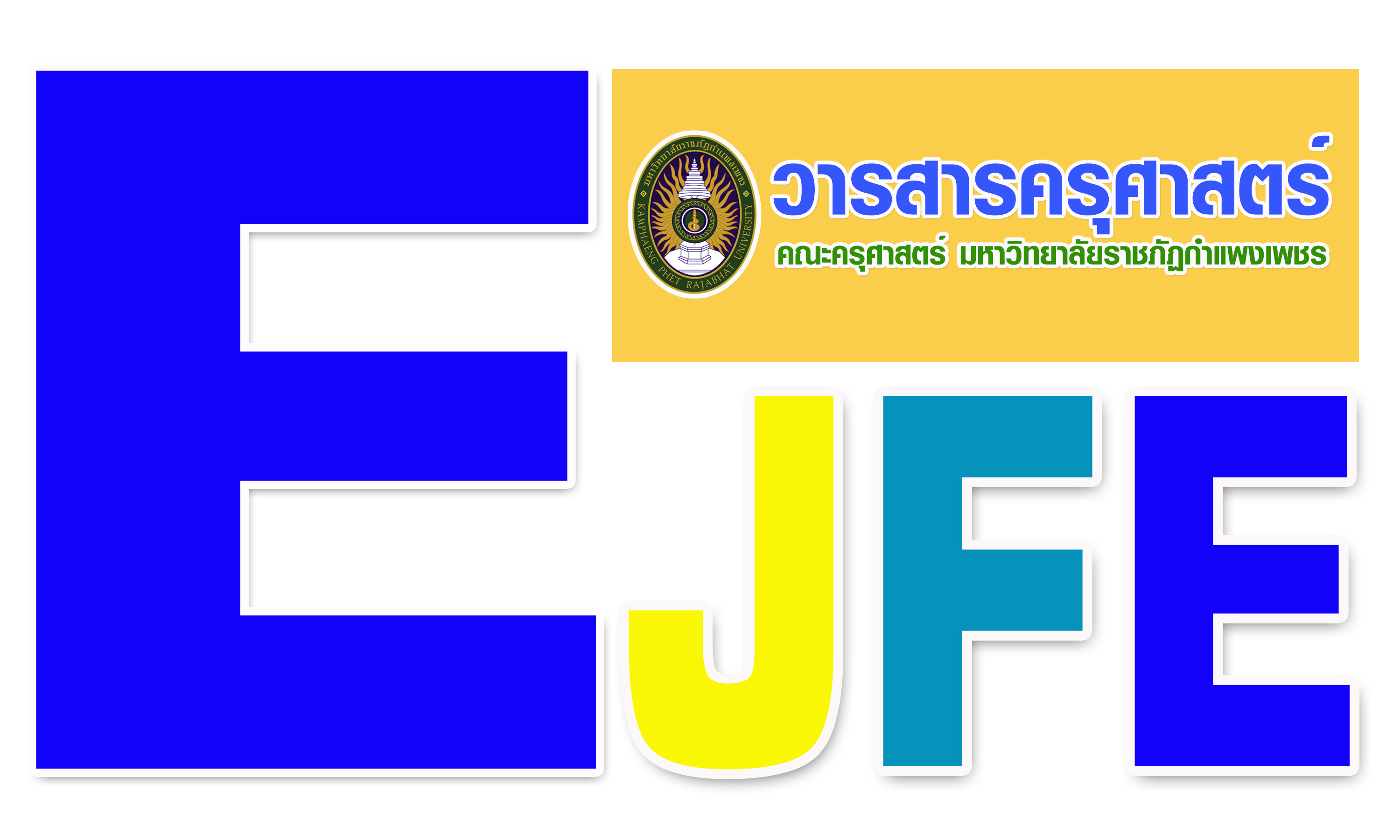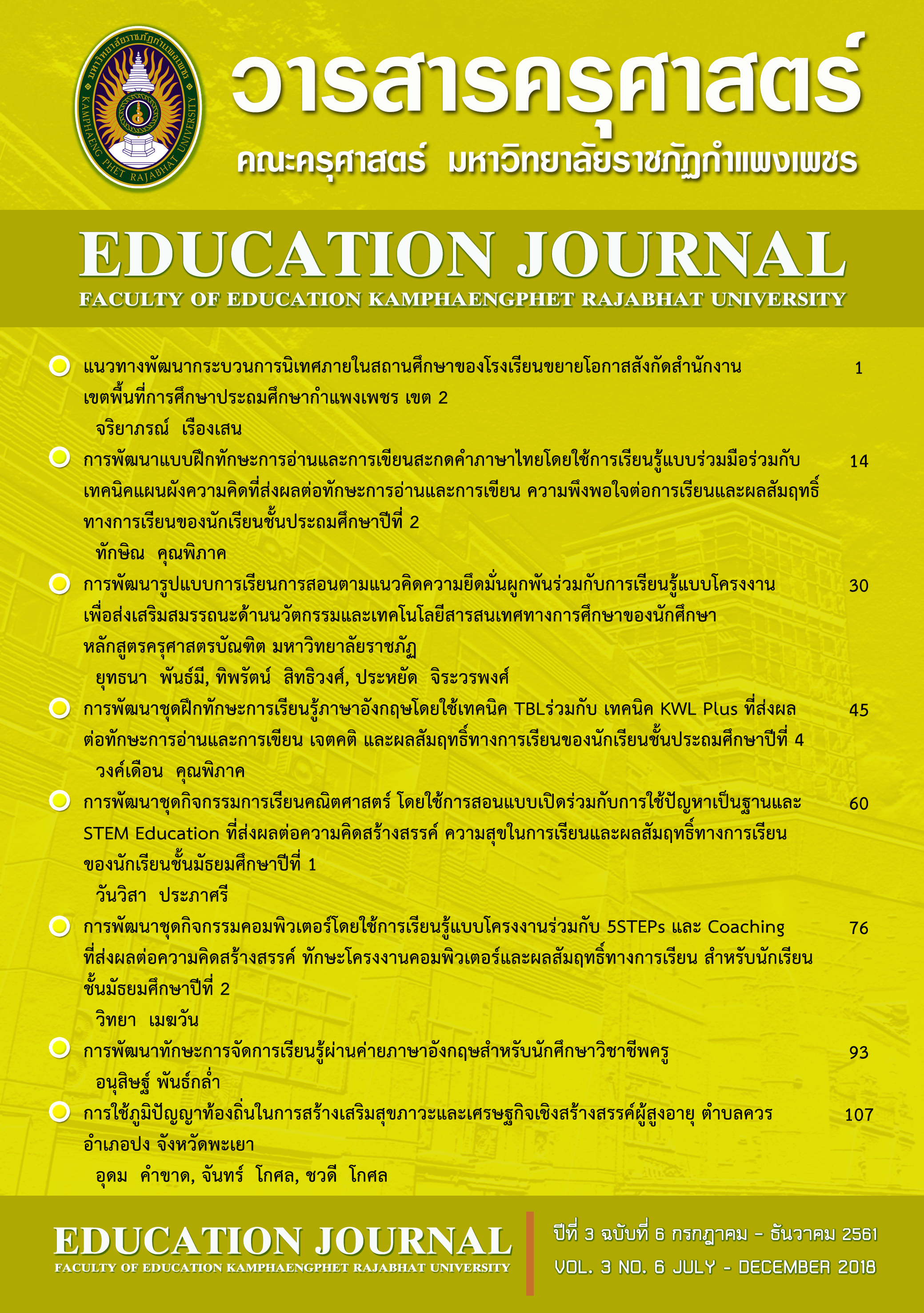การพัฒนาแบบฝึกทักษะการอ่านและการเขียนสะกดคำภาษาไทยโดยใช้การเรียนรู้ แบบร่วมมือร่วมกับเทคนิคแผนผังความคิดที่ส่งผลต่อทักษะการอ่านและการเขียน ความพึงพอใจต่อการเรียน และผลสัมฤทธิ์ทางการเรียน ของนักเรียนชั้นประถมศึกษาปีที่ 2
Main Article Content
บทคัดย่อ
การวิจัยครั้งนี้ มีความมุ่งหมายเพื่อศึกษาดัชนีประสิทธิผลของแบบฝึกทักษะการอ่านและการเขียนสะกดคำภาษาไทยโดยใช้การเรียนรู้แบบร่วมมือร่วมกับแผนผังความคิด เปรียบเทียบทักษะ การอ่านและการเขียนสะกดคำ และผลสัมฤทธิ์ทางการเรียนระหว่างก่อนเรียนและหลังเรียน เปรียบเทียบความพึงพอใจต่อการเรียนหลังเรียนกับเกณฑ์ที่ตั้งไว้ และเปรียบเทียบทักษะการอ่านและการเขียนสะกดคำ ความพึงพอใจต่อการเรียน และผลสัมฤทธิ์ทางการเรียนของนักเรียนที่มีแรงจูงใจใฝ่สัมฤทธิ์ต่างกัน (สูง ปานกลาง และต่ำ) หลังได้รับการเรียนด้วยแบบฝึกทักษะการอ่านและการเขียนสะกดคำภาษาไทย โดยใช้การเรียนรู้แบบร่วมมือร่วมกับเทคนิคแผนผังความคิด กลุ่มตัวอย่างเป็นนักเรียนชั้นประถมศึกษาปีที่ 2 โรงเรียนบ้านกุดสะกอย สังกัดสำนักงานเขตพื้นที่การศึกษาประถมศึกษาสกลนคร เขต 1 ภาคเรียนที่ 2 ปีการศึกษา 2560 จำนวน 21 คน ซึ่งได้มาจากการสุ่มแบบแบ่งกลุ่ม (Cluster Random Sampling) เครื่องมือที่ใช้ในการวิจัย ประกอบด้วย 1) แบบฝึกทักษะการอ่านและการเขียนสะกดคำภาษาไทย โดยใช้การเรียนรู้แบบร่วมมือร่วมกับเทคนิคแผนผังความคิด 2) แบบทดสอบวัดทักษะการอ่านและการเขียนสะกดคำ 3) แบบสอบถามความพึงพอใจต่อการเรียน 4) แบบทดสอบวัดผลสัมฤทธิ์ทางการเรียน และ 5) แบบสอบถามแรงจูงใจใฝ่สัมฤทธิ์ สถิติที่ใช้ในการวิเคราะห์ข้อมูล ได้แก่ ค่าเฉลี่ย ส่วนเบี่ยงเบนมาตรฐาน ค่าดัชนีประสิทธิผล (Effectiveness Index : E.I.) สถิติทดสอบค่าที (t–test for Dependent Samples and t–test for One Samples) การวิเคราะห์ความแปรปรวนแบบทางเดียว (ANOVA) การวิเคราะห์ความแปรปรวนร่วมพหุคูณแบบทางเดียว (MANCOVA) และ การวิเคราะห์ความแปรปรวนร่วมแบบทางเดียว (ANCOVA) ผลการวิจัยสรุปได้ดังนี้ 1. แบบฝึกทักษะการอ่านและการเขียนสะกดคำภาษาไทย โดยใช้การเรียนรู้แบบร่วมมือร่วมกับเทคนิคแผนผังความคิด มีค่าดัชนีประสิทธิผลเท่ากับ 0.59 คิดเป็นร้อยละ 59 2. ทักษะการอ่านและการเขียนสะกดคำ ของนักเรียนชั้นประถมศึกษาปีที่ 2 ที่เรียนด้วยแบบฝึกทักษะการอ่านและการเขียนสะกดคำภาษาไทย โดยใช้การเรียนรู้แบบร่วมมือร่วมกับเทคนิคแผนผังความคิด หลังเรียนสูงกว่าก่อนเรียนอย่างมีนัยสำคัญทางสถิติที่ระดับ .05 3. ความพึงพอใจต่อการเรียนของนักเรียนชั้นประถมศึกษาปีที่ 2 ที่เรียนด้วยแบบฝึกทักษะการอ่านและการเขียนสะกดคำภาษาไทย โดยใช้การเรียนรู้แบบร่วมมือร่วมกับเทคนิคแผนผังความคิดหลังเรียนอยู่ในระดับมากขึ้นไป อย่างมีนัยสำคัญทางสถิติที่ระดับ .05 4. ผลสัมฤทธิ์ทางการเรียนของนักเรียนชั้นประถมศึกษาปีที่ 2 ที่เรียนด้วยแบบฝึกทักษะการอ่านและการเขียนสะกดคำภาษาไทย โดยใช้การเรียนรู้แบบร่วมมือร่วมกับเทคนิคแผนผังความคิด หลังเรียนสูงกว่าก่อนเรียนอย่างมีนัยสำคัญทางสถิติที่ระดับ .05 5. ทักษะการอ่านและการเขียนสะกดคำ ความพึงพอใจต่อการเรียน และผลสัมฤทธิ์ทางการเรียน ของนักเรียนชั้นประถมศึกษาปีที่ 2 ที่มีแรงจูงใจใฝ่สัมฤทธิ์แตกต่างกัน หลังได้รับการเรียนด้วยแบบฝึกทักษะการอ่านและการเขียนสะกดคำภาษาไทย โดยใช้การเรียนรู้แบบร่วมมือร่วมกับเทคนิคแผนผังความคิด มีความแตกต่างกันอย่างมีนัยสำคัญทางสถิติที่ระดับ .05
Article Details

This work is licensed under a Creative Commons Attribution-NonCommercial 4.0 International License.
CC Attribution-NonCommercial-NoDerivatives 4.0
References
กรรณิการ์ ศรีวรชัย. (2557). การเปรียบเทียบผลสัมฤทธิ์ทางการเรียน ความคงทน ในการเรียนรู้ และจิตวิทยาศาสตร์ของนักเรียนชั้นมัธยมศึกษาปีที่ 6 ที่เรียนเรื่อง ไฟฟ้าเคมี ระหว่างการเรียนรู้ ตามทฤษฎีคอนสตรัคติวิสต์และการสร้างแผนผังความคิด.วิทยานิพนธ์ ค.ม. นครพนม: มหาวิทยาลัยนครพนม.
กระทรวงศึกษาธิการ. (2551). หลักสูตรแกนกลางการศึกษาขั้นพื้นฐานพุทธศักราช 2551. กรุงเทพฯ: โรงพิมพ์ชุมนุมสหกรณ์การเกษตรแห่งประเทศไทย.บังอร บารมีช่วย. (2550). การพัฒนาแผนการเรียนรู้ เรื่องการอ่านและการเขียนสะกดคำ ชั้นประถมศึกษาปีที่ 2 โดยใช้แบบฝึกทักษะ. วิทยานิพนธ์ กศ.ม. มหาสารคาม: มหาวิทยาลัยมหาสารคาม.
ประไทย ศุภวิทยาเจริญกุล. (2557). การพัฒนาแบบฝึกเสริมทักษะการอ่านและการเขียนสะกดคำ โดยใช้การเรียนรู้แบบร่วมมือ กลุ่มสาระการเรียนรู้ภาษาไทยชั้นประถมศึกษาปีที่ 2. วิทยานิพนธ์ ค.ม. สกลนคร: มหาวิทยาลัยราชภัฏสกลนคร.
พรรณวดี โตมาก. (2553). ผลการจัดกิจกรรมการเรียนรู้กลุ่มสาระภาษาไทยชั้นประถมศึกษาปีที่ 1 เรื่องการอ่านและเขียนสะกดคำ แจกลูกคำที่มีสระเปลี่ยนรูปและสระลดรูป โดยใช้ แผนผังความคิดประกอบการเรียนรู้แบบร่วมมือ. วิทยานิพนธ์ กศ.ม. มหาสารคาม: มหาวิทยาลัยมหาสารคาม.
ไพวรรณ ชาติผา และคณะ. (2556). การพัฒนาการอ่านและการเขียนคำที่มีตัวสะกดไม่ตรงมาตราโดยใช้แบบฝึกกลุ่มสาระการเรียนรู้ภาษาไทย ชั้นประถมศึกษาปีที่ 2.วารสารบัณฑิตศึกษา, 10(49), 133-140.
มยุรี เพ็ชรพินิจ. (2557). การพัฒนาชุดฝึกทักษะการอ่านและการเขียนคำควบกล้ำโดยใช้การเรียนแบบร่วมมือและการฝึกคิดแบบโยนิโสมนสิการที่ส่งผลต่อความรับผิดชอบ การคิดวิเคราะห์ และผลสัมฤทธิ์ทางการเรียนกลุ่มสาระการเรียนรู้ภาษาไทยของนักเรียนชั้นประถมศึกษาปีที่ 3. วิทยานิพนธ์ ค.ม. สกลนคร: มหาวิทยาลัยราชภัฏสกลนคร.
โรงเรียนบ้านกุดสะกอย. (2559). รายงานประจำปีของสถานศึกษาปีการศึกษา 2559 เอกสารลำดับที่ 4/2559. สกลนคร: โรงเรียนบ้านกุดสะกอย.วิมลรัตน์ สุนทรโรจน์. (2551). นวัตกรรมเพื่อการเรียนรู้. มหาสารคาม: ภาควิชาหลักสูตรและการสอน คณะศึกษาศาสตร์ มหาวิทยาลัยมหาสารคาม.
วิลาวัณย์ ธรรมชัย. (2550). ผลการจัดกิจกรรมการเรียนรู้ภาษาไทยโดยใช้แผนผังความคิดและแบบฝึกทักษะด้านการอ่านและการคิดวิเคราะห์ เรื่อง กระต่ายไม่ตื่นตูม ชั้นประถมศึกษา ปีที่ 3. (การศึกษาค้นคว้าอิสระการศึกษามหาบัณฑิต). มหาวิทยาลัยมหาสารคาม. สืบค้นจาก ฐานข้อมูลงานวิจัย ThaiLis Digital Collection. (15 พฤศจิกายน 2560).
สงวนสิน ญาติสมบูรณ์. (2553). ผลการจัดกิจกรรมการเรียนรู้ภาษาไทยเรื่องการอ่านและเขียนคำยาก โดยใช้เทคนิคแผนผังความคิดและแบบฝึกทักษะชั้นประถมศึกษาปีที่ 2. วิทยานิพนธ์ กศ.ม. มหาสารคาม: มหาวิทยาลัยมหาสารคาม.สำนักบริหารงานการมัธยมศึกษาตอนปลาย สพฐ. (2558). แนวทางการจัดทักษะการเรียนรู้ในศตวรรษที่ 21 ที่เน้นสมรรถนะสาขาวิชาชีพ. กรุงเทพฯ: กระทรงศึกษาธิการ.
สุนันทา สายแวว. (2552). การพัฒนาแบบฝึกทักษะการเขียนสะกดคำที่ประสมสระลดรูป-เปลี่ยนรูป ที่สะกดตรงตามมาตราตัวสะกด กลุ่มสาระการเรียนรู้ภาษาไทย สำหรับนักเรียนชั้นประถมศึกษาปีที่ 2. วิทยานิพนธ์ ค.ม. อุบลราชธานี: มหาวิทยาลัยราชภัฏอุบลราชธานี.
อภิชาติ ชมภูทัศน์. (2552). การพัฒนาชุดกิจกรรมส่งเสริมการเขียนบทร้อยกรองโดยเน้นการเรียนรู้แบบร่วมมือ กลุ่มสาระการเรียนรู้ภาษาไทย ชั้นมัธยมศึกษาปีที่ 2. วิทยานิพนธ์ ค.ม. สกลนคร: มหาวิทยาลัยราชภัฏสกลนคร.
อรพรรณ ธุนาบาล. (2555). การพัฒนาชุดกิจกรรมส่งเสริมทักษะการอ่านและการเขียนควบกล้ำ เน้นการเรียนรู้แบบร่วมมือ ชั้นประถมศึกษาปีที่ 2. วิทยานิพนธ์ ค.ม. สกลนคร: มหาวิทยาลัยราชภัฏสกลนคร.
อัมพวรรณ์ โคโตสี. (2550). การพัฒนาแผนการจัดการเรียนรู้และแบบฝึกทักษะการสะกดคำ กลุ่มสาระการเรียนรู้ภาษาไทยชั้นประถมศึกษาปีที่ 2 โรงเรียนอนุบาลศรีวิไล สำนักงานเขตพื้นที่การศึกษาหนองคาย เขต 3. วิทยานิพนธ์ ค.ม. มหาสารคาม: มหาวิทยาลัยราชภัฏมหาสารคาม.

